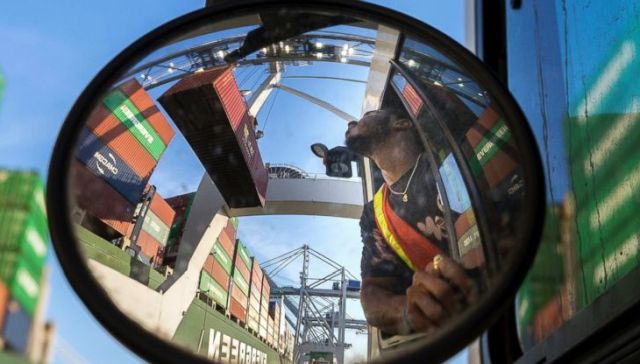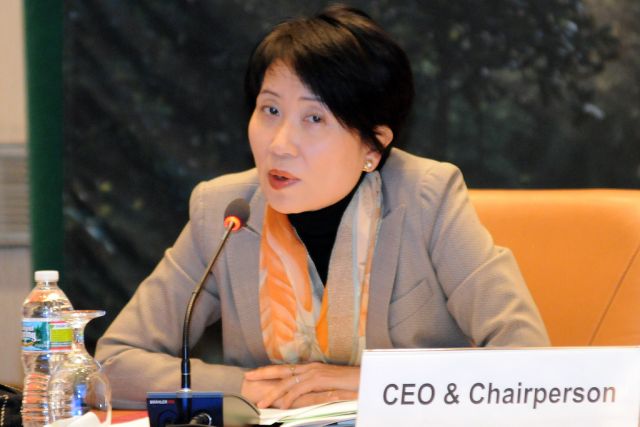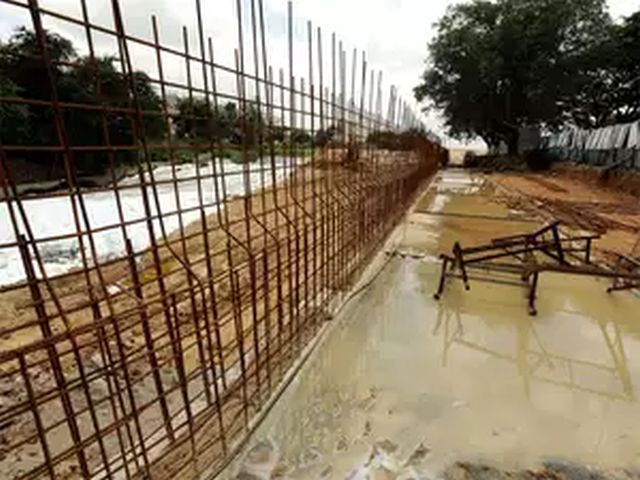
by admin | May 25, 2021 | Business, Emerging Businesses, Medium Enterprise, World
 By Gaurav Sharma,
By Gaurav Sharma,
Beijing : A trade war between China and the US – the world’s largest economies – began on Friday as the two sides started slapping additional tariffs on each other’s goods, worth nearly $70 billion, a development that could impede global economic recovery.
As planned, Washington began taxing 818 Chinese goods worth $34 billion early on Friday to punish Beijing for allegedly playing underhand in trade practices and pressuring US companies to hand over their technologies for doing business in China.
Beijing, which denies these charges, was swift in responding in kind after the first tranche of planned US levies on Chinese goods announced by President Donald Trump kicked in on Friday.
“After the US imposed its tariffs, China also took effective measures,” said Chinese Foreign Ministry spokesperson Lu Kang.
Even though neither Lu nor the Chinese Commerce ministry gave details about the scales of tariffs, Beijing has plans to slap punishing levies 545 US products worth $34 billion a year that range from soybeans and lobsters to sport utility vehicles and whiskey.
The duties slapped by the US will make Chinese cough an additional 25 percent on products such as industrial machinery, medical devices and auto parts.
Reacting to the tariffs, the Chinese Commerce Ministry said: “The US has ignited the largest trade war in economic history.
“The Chinese side, having vowed not to fire the first shot, is forced to stage counter-attacks to protect the core national interests and interests of its people.”
The Chinese Foreign Ministry said the US had blatantly violated the WTO rules.
“It will surely impact the global trade order, trigger global market fluctuation and impede economic recovery.” spokesperson Lu Kang said.
“More multinational companies, SMEs and ordinary consumers will be impaired and many industries in the US have realised that it is them that will bear the consequences.”
On Thursday, Trump showed no signs of backing down from his fight and suggested the possibility of tariffs on almost $500 billion more of Chinese goods.
“Thirty-four, and then you have another 16 in two weeks and then, as you know, we have 200 billion in abeyance and then after the 200 billion, we have 300 billion in abeyance. OK?” Trump told reporters aboard the Air Force One.
“So we have 50 plus 200 plus almost 300.”
Following Friday’s development, the Shanghai Composite index fell 1.1 percent, after reaching more than a two-year low this week, reports the Guardian.
Trump and his advisers argue the tariffs are necessary to pressure China into abandoning unfair practices such as stealing intellectual property and forcing American companies to hand over valuable technology, reports CNN.
In addition to the tariffs, the White House is placing restrictions on investment and on visas for Chinese nationals.
The clash with China comes as the Trump administration is also fighting over trade with American allies such as Canada and the European Union.
American tariffs on steel and aluminum imports have provoked retaliatory measures against billions of dollars of American exports.
—IANS

by admin | May 25, 2021 | Economy, News, World

Global Environment Facility (GEF) CEO and Chairperson Naoko Ishii
By Vishal Gulati,
Da Nang : Humans must transform their key economic systems and move to a circular economy to restore the ecosystems. The transformation is needed and is possible, a top environmentalist has said.
Global Environment Facility (GEF) CEO and Chairperson Naoko Ishii told the opening session of its two-day assembly, sixth in series, that saw over 1,000 delegates across the globe in this Vietnamese port city on Wednesday that this was “a critical moment for the future of our planet and its people”.
The opening session also saw the presence of Vietnamese Prime Minister Nguyen Xuan Phuc along with delegates from across the globe, including India, top heads of UN agencies and multilateral financial institutions, scientists and business leaders.
Heads of island nations vulnerable to rising sea levels caused by melting ice, like the Marshall Islands President Hilda Heine and Guyana President David Granger also attended.
“For the past half century, we humans have made lots of progress in our societies. But we are putting huge pressure on the health of our planet,” Ishii said.
“Every day we are receiving wake-up calls from nature; massive loss of forests and lands, species being lost, pollution of air and water. And we are suffering from increasingly visible impacts of climate, coastal cities such as Da Nang are vulnerable, and so are small islands states.”
The GEF was created more than 25 years ago to help fight against these threats, she said.
Its assembly is the governing body of the GEF, a mechanism to provide grants for environment projects, and is composed of all 183 member countries.
Going down memory lane, Ishii said she remembered the days she spent in this port city 20 years ago.
“I was here in Da Nang 20 years ago, working on a World Bank urban project, focusing on second tier cities. I remember we were walking around the streets and asking people about their desire for safe drinking water. Well, 20 years have passed, and Da Nang is not a second tier city anymore. It is a major city with modern infrastructure and international links.”
Sounding an alarming note, the GEF chief said: “We continue to push the carrying capacity of our planet to its breaking point. Business as usual will guarantee disaster.”
“Scientists tell us that we have entered into the aanthropocene’ where humans are the dominant force changing the function of earth. So we, humans, must change.”
“We must transform our key economic systems; our food and land use system, our cities, our energy system, and move on to a circular economy. We must restore the ecosystems that are the very foundation for our societies and economies as we know them,” he said.
Still an optimistic Ishii said “there is a hope”
“Up to the 2015 Paris climate agreement, there emerged a number of like-minded collations among business, cities, governments, academia and citizens, which played key role to Paris agreement.”
“And the sustainable development goals provide a good framework to hold us together to catalyze the necessary change.”
The Vietnamese Prime Minister, in his welcome address, said integrated solutions are needed to address global threats like marine plastic and biodiversity loss to protect the planet.
The GEF Assembly is meeting two months after governments, in a demonstration of confidence, approved a $4.1 billion replenishment of its new four-year investment cycle, known as GEF-7.
(Vishal Gulati is in Da Nang for the Internews’ Earth Journalism Network Biodiversity Fellowship Programme at the Sixth Global Environment Facility (GEF) Assembly. He can be reached at vishal.g@ians.in)
—IANS

by admin | May 25, 2021 | Muslim World
 By Fares Karam,
By Fares Karam,
Istanbul: Iran’s parliament held a closed-door session on Tuesday to discuss the country’s economic situation amid expectations of a fresh round of U.S. sanctions against Tehran.
Iran continues to face a host of serious economic challenges, including high unemployment and a weakening currency, due largely to longstanding U.S. economic sanctions.
MP Fatima Zul Qadr told Iran’s IRNA news agency on Tuesday that parliamentarians had discussed “developments pertaining to the [Iranian] currency market and demonstrations that occurred Monday in Tehran”.
At Tuesday’s parliament session, Zul Qadr said, Assembly Speaker Ali Larijani had presented a report to MPs on the country’s current economic situation.
Many Iranian traders and importers face difficulties obtaining foreign currency, which they need to pay for imported commodities.
On Monday, Iranian traders staged a demonstration outside the parliament building in Tehran to protest worsening economic conditions.
According to local media reports, demonstrators decried rising costs of living, demanding that politicians move swiftly to resolve the country’s chronic economic woes.
—AA

by admin | May 25, 2021 | Investing, Opinions
 By Taponeel Mukherjee,
By Taponeel Mukherjee,
Perspectives on infrastructure assets vary widely: While investors focus on investment returns, policymakers analyse both financial and socio-economic benefits. It would be worthwhile for policymakers to view things through an investor’s investment prism because an understanding of the critical factors that shape investment decisions will help frame better policies to expedite Indian infrastructure creation.
The “raw value” of an infrastructure project is what a potential investor evaluates first. For example, in a renewable energy wind project, the wind potential of a site is what an investor evaluates. For a transportation project, the investor evaluates the potential passenger traffic. This so-called “raw value” is a huge determinant of the financial viability of a project.
Segregating infrastructure sectors and projects by such “raw value” can help government and industry alike to work towards directing infrastructure capital more optimally. Additionally, such analysis helps in framing policies for those sectors that deliver very substantial social and economic value but are not financially viable on their own.
A robust framework that helps determine “raw value” can aid all the stakeholders, especially the government, to work with investors and multilateral trade agencies to find financing solutions for such socially and economically relevant projects. Eventually, India needs to create an information repository of sorts that provides the global investor base information and access by asset type and investment potential.
Once the “raw value” of a project is determined, an investor tries to gauge what is called its “scarcity value”. Take, for instance, transportation projects. If the transportation potential of connecting City “A” with City “B” is attractive, then is building an airport to connect the two cities the most optimal infrastructure asset? That is, in spite of the traffic potential, is an airport a “scarce” enough asset to deliver attractive returns?
The investor will gauge whether the airport is likely to face competition from a competing train network or a highway. Being cognizant of the long-dated nature of infrastructure assets is important. Hence investors will have to gauge the “scarcity value” of the asset to determine the attractiveness of the asset over the long investment horizon and, therefore, eventually decide on their willingness to invest in the asset.
It is essential for the government to find a balance between allowing investors to make returns commensurate with the risk taken and allowing the public to have access to a well-priced and high-quality infrastructure asset. The twin objectives of consistency and transparency in policy are crucial in this regard.
The government’s ability to formulate and communicate the strategy effectively regarding not just sectors but individual assets is vital. To indeed expedite infrastructure creation, granular policy across industries will be needed, more so for much-needed greenfield infrastructure projects.
Apart from “raw value” and “scarcity value”, an investor considers a third factor: The quality of the underlying contracts signed for the asset. Investors look for high-quality counter-parties with whom to sign contracts. More importantly, the government’s ability to deliver a robust legal system for contract-enforcement, as also a more efficient system for conflict-resolution, will attract more significant investments.
Lowering the risk perception for Indian infrastructure assets is essential not merely to attract more investments but also to attract investments at lower financing costs. Reducing the cost of capital is going to be a significant driver of infrastructure projects through their improved financial viability.
Another area that merits attention is the possibility of the government working even more closely with Export Credit Agencies of various countries to offer foreign exchange hedges, while “importing infrastructure investments”. Solutions that not only reduce the legal risk in investments but also partially eliminate the foreign exchange risk can help boost investments significantly.
Active policies to address the three issues revolving around the value, scarcity and contract enforcement that investors utilise to determine both investments and the required rate of return can help make policies useful.
Policy frameworks can potentially be refined using these three key factors that shape investment decisions. Most importantly, one does not need to improve concurrently on all three fronts for all infrastructure sectors; incremental improvement on one element can provide a significant fillip to infrastructure investments.
(Taponeel Mukherjee heads Development Tracks, an infrastructure advisory firm. Views expressed are personal. He can contacted at taponeel.mukherjee@development-tracks.com or @Taponeel on Twitter)
—IANS

by admin | May 25, 2021 | Opinions
 By Amit Kapoor,
By Amit Kapoor,
Any undergraduate student of economics would vouch for the fact that an economy in a recession requires a fiscal stimulus package (or more government spending and lower taxes). Such a stimulus can only be managed if the economy constrains its fiscal spending in times of growth. Restraint on spending in good times would allow the creation of a buffer for a strong fiscal policy response in the event of a downturn. This Keynesian prescription of counter-cyclical fiscal policy is expected to stabilise output of an economy over business cycle dynamics.
The world economy today, however, is on a problematic course. The International Monetary Fund (IMF) pointed out last week that the global debt levels have reached historical highs. In 2016, the global debt stood at $164 trillion, which was equivalent to 225 percent of global GDP. The current levels of global debt-to-GDP ratio are a whole 12 percentage points higher than the previous peak of 2009 when the governments were on a deficit spending spree in the aftermath of the global financial crisis.
Also, it turns out that countries in all income groups have accumulated massive amounts of debt. In advanced countries, the debt-to-GDP ratios have hit levels not seen since World War II, while the emerging markets and middle-income countries are at levels last seen during the 1980s debt crisis. The current debt situation has been a result of the prolonged after-effects of the 2008 financial crisis, which have only recently worn off.
Excess liquidity is generated in a system when the economic growth rate is lower than the amount of money circulating in the economy. When banks have more money in their reserves than required, they resort to lending at lower interest rates. These low interest rates encourage higher borrowing by governments, individuals and corporates. Over the last few years, since the world was in a low-growth phase and interest rates were at rock bottom, debt was continually rising.
Meanwhile, the US economy, which had to resort to a similar low-interest phase, is continuing to strain its fiscal situation. Despite having massive spending obligations in the form of entitlement programmes, the Trump administration opted for generous tax cuts with no commensurate revenue generating plan. The expansionary fiscal policy has come at a time when the US economy is at its strongest in a decade. The fiscal deficit is expected to reach $1 trillion soon.
China is in a more precarious situation. The country has moved from being a low-leverage country in 2007 to having a debt position that is currently worse than the US. In a bid to sustain its growth story, the Chinese government authorised a decade-long debt explosion. Even though most of its debt has been accumulated by the corporate sector, a large part of it has been incurred by state-owned enterprises backed by central and local governments. So, the state has played an enabling role in inculcating the behaviour of unrestrained borrowing.
Now that the world economy is finally on a cyclical upswing, the escalating debt addiction needs to come to an end and fiscal buffers should be strengthened to reduce the risk of financial difficulties in case global financial conditions tighten suddenly.
The necessity of winding down debt levels right away has been shown in a paper published last year by David Romer and Christina Romer. After analysing 24 economies, the two economists convincingly showed that if a country has both fiscal and monetary space in time of a crisis, the economy’s output contracted by less than 1 percent. However, if that was not the case, the output declines by about 10 percent. Therefore, it is absolutely vital that the world economies begin to work towards enhancing their resilience.
Against this backdrop, the focus of the Indian government on the practice of fiscal restraint seems to be on the right track. The N.K. Singh Committee had recommended a combined debt-to-GDP ratio of 60 percent by 2022-23 and the IMF estimates that India will definitely miss the target but would be close enough. The only cause of concern is the deteriorating condition of state finances.
The Fourteenth Finance Commission had recommended anchoring the fiscal deficit of the states to 3 percent of the GSDP between 2015-16 and 2019-20. However, the states have not been able to achieve the target till date. The breaching of targets is not worrying if borrowing is undertaken to fund productive activities like improving infrastructure. But, Indian states are neck deep in debt only due to pandering to populist sentiments.
If the government efforts to synchronise general and state elections materialise, the fiscal deficit will take an even further hit. It would be in the best interest of the economy if such short-term political temptations are avoided. India should aim at building up its fiscal resilience while the economic situation is strong.
(Amit Kapoor is chair, Institute for Competitiveness. He can be contacted at amit.kapoor@competitiveness.in and tweets @kautiliya. Chirag Yadav, senior researcher, Institute for Competitiveness, has contributed to the article)
—IANS





